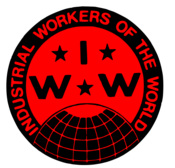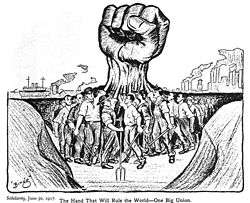Industrial Workers of the World
The Industrial Workers of the World (IWW), members of which are commonly termed "Wobblies", is an international labor union that was founded in 1905 in Chicago, Illinois, in the United States. The union combines general unionism with industrial unionism, as it is a general union, subdivided between the various industries which employ its members. The philosophy and tactics of the IWW are described as "revolutionary industrial unionism", with ties to both socialist[4] and anarchist labor movements.
.svg.png) | |
| Full name | Industrial Workers of the World |
|---|---|
| Founded | June 27, 1905[1][2] |
| Members | |
| Journal | Industrial Worker |
| Key people | § Notable members |
| Office location | Chicago, Illinois, U.S. |
| Country | International |
| Website | www |
In the 1910s and early 1920s, the IWW achieved many of their short-term goals, particularly in the American West, and cut across traditional guild and union lines to organize workers in a variety of trades and industries. At their peak in August 1917, IWW membership was more than 150,000, with active wings in the United States, Canada, and Australia.[5] The extremely high rate of IWW membership turnover during this era (estimated at 133% per decade) makes it difficult for historians to state membership totals with any certainty, as workers tended to join the IWW in large numbers for relatively short periods (e.g., during labor strikes and periods of generalized economic distress).[6]
Due to several factors, membership declined dramatically in the late 1910s and 1920s. There were conflicts with other labor groups, particularly the American Federation of Labor (AFL), which regarded the IWW as too radical, while the IWW regarded the AFL as too conservative and dividing workers by craft.[7] Membership also declined due to government crackdowns on radical, anarchist and socialist groups during the First Red Scare after World War I. In Canada the IWW was outlawed by the federal government.
Probably the most decisive factor in the decline in IWW membership and influence, however, was a 1924 schism in the organization, from which the IWW never fully recovered.[7][8]
The IWW promotes the concept of "One Big Union", and contends that all workers should be united as a social class to supplant capitalism and wage labor with industrial democracy.[9] They are known for the Wobbly Shop model of workplace democracy, in which workers elect their managers[10] and other forms of grassroots democracy (self-management) are implemented. IWW membership does not require that one work in a represented workplace,[11] nor does it exclude membership in another labor union.[12]
In 2012, the IWW moved its General Headquarters offices to 2036 West Montrose in Chicago.[13] The origin of the nickname "Wobblies" is uncertain.[14]
History 1905–1950
Founding
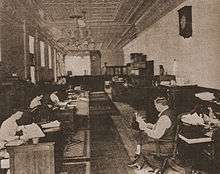
The first meeting to plan the IWW was held in Chicago in 1904. The six attendees were Clarence Smith and Thomas J. Hagerty of the American Labor Union, George Estes and W. L. Hall of the United Brotherhood of Railway Employees, Isaac Cowan of the U.S. branch of the Amalgamated Society of Engineers, and William E. Trautmann of the United Brewery Workmen. Eugene Debs, formerly of the American Railway Union, and Charles O. Sherman of the United Metal Workers were involved but were unable to attend the meeting.[15]
The IWW was officially founded in Chicago, Illinois in June 1905. A convention was held of 200 socialists, anarchists, Marxists (primarily members of the Socialist Party of America and Socialist Labor Party of America), and radical trade unionists from all over the United States (mainly the Western Federation of Miners) who strongly opposed the policies of the American Federation of Labor (AFL). The IWW opposed the American Federation of Labor's acceptance of capitalism and its refusal to include unskilled workers in craft unions.[16]
The convention had taken place on June 24, 1905, and was referred to as the "Industrial Congress" or the "Industrial Union Convention". It would later be known as the First Annual Convention of the IWW.[6]:67 It later became considered one of the most important events in the history of industrial unionism.[6]:67
The IWW's founders included William D. ("Big Bill") Haywood, James Connolly, Daniel De Leon, Eugene V. Debs, Thomas Hagerty, Lucy Parsons, Mary Harris "Mother" Jones, Frank Bohn, William Trautmann, Vincent Saint John, Ralph Chaplin, and many others.
The IWW aimed to promote worker solidarity in the revolutionary struggle to overthrow the employing class; its motto was "an injury to one is an injury to all", which improved upon the Knights of Labor's creed, "an injury to one is the concern of all" which was at its most popular in the 1880s. In particular, the IWW was organized because of the belief among many unionists, socialists, anarchists, Marxists, and radicals that the AFL not only had failed to effectively organize the U.S. working class, but it was causing separation rather than unity within groups of workers by organizing according to narrow craft principles. The Wobblies believed that all workers should organize as a class, a philosophy which is still reflected in the Preamble to the current IWW Constitution:
The working class and the employing class have nothing in common. There can be no peace so long as hunger and want are found among millions of the working people and the few, who make up the employing class, have all the good things of life.
Between these two classes a struggle must go on until the workers of the world organize as a class, take possession of the means of production, abolish the wage system, and live in harmony with the Earth.
We find that the centering of the management of industries into fewer and fewer hands makes the trade unions unable to cope with the ever growing power of the employing class. The trade unions foster a state of affairs which allows one set of workers to be pitted against another set of workers in the same industry, thereby helping defeat one another in wage wars. Moreover, the trade unions aid the employing class to mislead the workers into the belief that the working class have interests in common with their employers.
These conditions can be changed and the interest of the working class upheld only by an organization formed in such a way that all its members in any one industry, or in all industries if necessary, cease work whenever a strike or lockout is on in any department thereof, thus making an injury to one an injury to all.
Instead of the conservative motto, "A fair day's wage for a fair day's work," we must inscribe on our banner the revolutionary watchword, "Abolition of the wage system."
It is the historic mission of the working class to do away with capitalism. The army of production must be organized, not only for everyday struggle with capitalists, but also to carry on production when capitalism shall have been overthrown. By organizing industrially we are forming the structure of the new society within the shell of the old.[9]
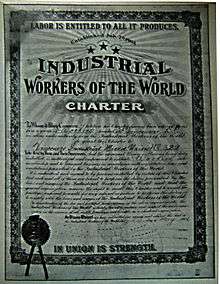
The Wobblies, as they were informally known, differed from other union movements of the time by promotion of industrial unionism, as opposed to the craft unionism of the American Federation of Labor. The IWW emphasized rank-and-file organization, as opposed to empowering leaders who would bargain with employers on behalf of workers. The early IWW chapters' consistently refused to sign contracts, which they believed would restrict workers' abilities to aid each other when called upon. Though never developed in any detail, Wobblies envisioned the general strike as the means by which the wage system would be overthrown and a new economic system ushered in, one which emphasized people over profit, cooperation over competition.
One of the IWW's most important contributions to the labor movement and broader push towards social justice was that, when founded, it was the only American union to welcome all workers, including women, immigrants, African Americans and Asians, into the same organization. Many of its early members were immigrants, and some, such as Carlo Tresca, Joe Hill and Elizabeth Gurley Flynn, rose to prominence in the leadership. Finns formed a sizeable portion of the immigrant IWW membership. "Conceivably, the number of Finns belonging to the I.W.W. was somewhere between five and ten thousand."[17] The Finnish-language newspaper of the IWW, Industrialisti, published in Duluth, Minnesota, a center of the mining industry, was the union's only daily paper. At its peak, it ran 10,000 copies per issue. Another Finnish-language Wobbly publication was the monthly Tie Vapauteen ("Road to Freedom"). Also of note was the Finnish IWW educational institute, the Work People's College in Duluth, and the Finnish Labour Temple in Port Arthur, Ontario, Canada, which served as the IWW Canadian administration for several years. Further, many Swedish immigrants, particularly those blacklisted after the 1909 Swedish General Strike, joined the IWW and set up similar cultural institutions around the Scandinavian Socialist Clubs. This in turn exerted a political influence on the Swedish labour movement's left, that in 1910 formed the Syndicalist union SAC which soon contained a minority seeking to mimick the tactics and strategies of the IWW.[18] One example of the union's commitment to equality was Local 8, a longshoremen's branch in Philadelphia, one of the largest ports in the nation in the WWI era. Led by Ben Fletcher, an African American, Local 8 had more than 5,000 members, the majority of whom were African American, along with more than a thousand immigrants (primarily Lithuanians and Poles), Irish Americans, and numerous white ethnics.
Divide on political action or direct action
In 1908 a group led by Daniel DeLeon argued that political action through DeLeon's Socialist Labor Party (SLP) was the best way to attain the IWW's goals. The other faction, led by Vincent Saint John, William Trautmann, and Big Bill Haywood, believed that direct action in the form of strikes, propaganda, and boycotts was more likely to accomplish sustainable gains for working people; they were opposed to arbitration and to political affiliation. Haywood's faction prevailed, and De Leon and his supporters left the organization, forming their own version of the IWW. The SLP's "Yellow IWW" eventually took the name Workers' International Industrial Union, which was disbanded in 1924.

Organizing
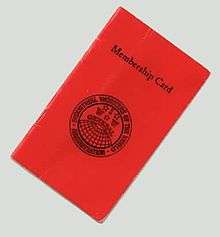
— Helen Keller, IWW member, 1911[19]
The IWW first attracted attention in Goldfield, Nevada in 1906 and during the Pressed Steel Car Strike of 1909[20] at McKees Rocks, Pennsylvania. Further fame was gained later that year, when they took their stand on free speech. The town of Spokane, Washington, had outlawed street meetings, and arrested Elizabeth Gurley Flynn,[21] a Wobbly organizer, for breaking this ordinance. The response was simple but effective: when a fellow member was arrested for speaking, large numbers of people descended on the location and invited the authorities to arrest all of them, until it became too expensive for the town. In Spokane, over 500 people went to jail and four people died. The tactic of fighting for free speech to popularize the cause and preserve the right to organize openly was used effectively in Fresno, Aberdeen, and other locations. In San Diego, although there was no particular organizing campaign at stake, vigilantes supported by local officials and powerful businessmen mounted a particularly brutal counter-offensive.
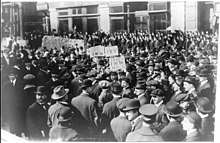
By 1912 the organization had around 25,000 members,[22] concentrated in the Northwest, among dock workers, agricultural workers in the central states, and in textile and mining areas. The IWW was involved in over 150 strikes, including the Lawrence textile strike (1912), the Paterson silk strike (1913) and the Mesabi range (1916). They were also involved in what came to be known as the Wheatland Hop Riot on August 3, 1913.
Geography
In its first decades, the IWW created more than 900 unions located in more than 350 cities and towns in 38 states and territories of the United States and 5 Canadian provinces.[23] Throughout the country, there were 90 newspapers and periodicals affiliated with the IWW, published in 19 different languages. Members of the IWW were active throughout the country and were involved in the Seattle General Strike,[24] were arrested or killed in the Everett Massacre,[25] organized among Mexican workers in the Southwest,[26] became a largest and powerful longshoremen's union in Philadelphia,[27] and more.
IWW versus AFL Carpenters, Goldfield, Nevada, 1907
The IWW assumed a prominent role in 1906 and 1907, in the gold-mining boom town of Goldfield, Nevada. At that time, the Western Federation of Miners was still an affiliate of the IWW (the WFM withdrew from the IWW in the summer of 1907). In 1906, the IWW became so powerful in Goldfield that it could dictate wages and working conditions.
Resisting IWW domination was the AFL-affiliated Carpenters Union. In March 1907, the IWW demanded that the mines deny employment to AFL Carpenters, which led mine owners to challenge the IWW. The mine owners banded together and pledged not to employ any IWW members. The mine and business owners of Goldfield staged a lockout, vowing to remain shut until they had broken the power of the IWW. The lockout prompted a split within the Goldfield workforce, between conservative and radical union members.[28]
The mine owners persuaded the Nevada governor to ask for federal troops. Under the protection of federal troops, the mine owners reopened the mines with non-union labor, breaking the influence of the IWW in Goldfield.
The Haywood trial and the exit of the Western Federation of Miners
Leaders of the Western Federation of Miners such as Bill Haywood and Vincent St. John were instrumental in forming the IWW, and the WFM affiliated with the new union organization shortly after the IWW was formed. The WFM became the IWW's "mining section." However, many in the rank and file of the WFM were uncomfortable with the open radicalism of the IWW, and wanted the WFM to maintain its independence. Schisms between the WFM and IWW had emerged at the annual IWW convention in 1906, when a majority of WFM delegates walked out.[6]
When WFM executives Bill Haywood, George Pettibone, and Charles Moyer were accused of complicity in the murder of former Idaho governor Frank Steunenberg, the IWW used the case to raise funds and support, and paid for the legal defense. However, even the not guilty verdicts worked against the IWW, because the IWW was deprived of martyrs, and at the same time, a large portion of the public remained convinced of the guilt of the accused.[29] The trials caused a bitter split between Haywood and Moyer. The Haywood trial also provoked a reaction within the WFM against violence and radicalism. In the summer of 1907, the WFM withdrew from the IWW, Vincent St. John left the WFM to spend his time organizing the IWW.
Bill Haywood for a time remained a member of both organizations. His murder trial had made Haywood a celebrity, and he was in demand as a speaker for the WFM. However, his increasingly radical speeches became more at odds with the WFM, and in April 1908, the WFM announced that the union had ended Haywood's role as a union representative. Haywood left the WFM, and devoted all his time to organizing for the IWW.[6]:216–217
Historian Vernon H. Jensen has asserted that the IWW had a "rule or ruin" policy, under which it attempted to wreck local unions which it could not control. From 1908 to 1921, Jensen and others have written, the IWW attempted to win power in WFM locals which had once formed the federation's backbone. When it could not do so, IWW agitators undermined WFM locals, which caused the national union to shed nearly half its membership.[30][31][32][33][34][35][36]
IWW versus the Western Federation of Miners
The Western Federation of Miners left the IWW in 1907, but the IWW wanted the WFM back. The WFM had made up about a third of the IWW membership, and the western miners were tough union men, and good allies in a labor dispute. In 1908, Vincent St. John tried to organize a stealth takeover of the WFM. He wrote to WFM organizer Albert Ryan, encouraging him to find reliable IWW sympathizers at each WFM local, and have them appointed delegates to the annual convention by pretending to share whatever opinions of that local needed to become a delegate. Once at the convention, they could vote in a pro-IWW slate. St. Vincent promised: “… once we can control the officers of the WFM for the IWW, the big bulk of the membership will go with them.” But the takeover did not succeed.[37]
In 1914, Butte, Montana, erupted into a series of riots as miners dissatisfied with the Western Federation of Miners local at Butte formed a new union, and demanded that all miners join the new union, or be subject to beatings or worse. Although the new rival union had no affiliation with the IWW, it was widely seen as IWW-inspired. The leadership of the new union contained many who were members of the IWW, or agreed with the IWW's methods and objectives. However, the new union failed to supplant the WFM, and the ongoing fight between the two factions had the result that the copper mines of Butte, which had long been a union stronghold for the WFM, became open shops, and the mine owners recognized no union from 1914 until 1934.[38]
IWW versus United Mine Workers, Scranton, Pennsylvania, 1916
The IWW clashed with the United Mine Workers union in April 1916, when the IWW picketed the anthracite mines around Scranton, Pennsylvania, intending, by persuasion or force, to keep UMWA members from going to work. The IWW considered the UMWA too reactionary, because the United Mine Workers negotiated contracts with the mine owners for fixed time periods; the IWW considered that contracts hindered their revolutionary goals. In what a contemporary writer pointed out was a complete reversal of their usual policy, UMWA officials called for police to protect United Mine Workers members who wished to cross the picket lines. The Pennsylvania State Police arrived in force, prevented picket line violence, and allowed the UMWA members to peacefully pass through the IWW picket lines.[6][39]
Between 1915 and 1917, the IWW's Agricultural Workers Organization (AWO) organized more than a hundred thousand migratory farm workers throughout the Midwest and western United States,[40] often signing up and organizing members in the field, in rail yards and in hobo jungles. During this time, the IWW member became synonymous with the hobo riding the rails; migratory farmworkers could scarcely afford any other means of transportation to get to the next jobsite. Railroad boxcars, called "side door coaches" by the hobos, were frequently plastered with silent agitators from the IWW.
Building on the success of the AWO, the IWW's Lumber Workers Industrial Union (LWIU) used similar tactics to organize lumberjacks and other timber workers, both in the deep South and the Pacific Northwest of the United States and Canada, between 1917 and 1924. The IWW lumber strike of 1917 led to the eight-hour day and vastly improved working conditions in the Pacific Northwest. Though mid-century historians would give credit to the US Government and "forward thinking lumber magnates" for agreeing to such reforms, an IWW strike forced these concessions.[41]
From 1913 through the mid-1930s, the IWW's Marine Transport Workers Industrial Union (MTWIU), proved a force to be reckoned with and competed with AFL unions for ascendance in the industry. Given the union's commitment to international solidarity, its efforts and success in the field come as no surprise. Local 8 of the Marine Transport Workers was led by Ben Fletcher, who organized predominantly African-American longshoremen on the Philadelphia and Baltimore waterfronts, but other leaders included the Swiss immigrant Walter Nef, Jack Walsh, E.F. Doree, and the Spanish sailor Manuel Rey. The IWW also had a presence among waterfront workers in Boston, New York City, New Orleans, Houston, San Diego, Los Angeles, San Francisco, Eureka, Portland, Tacoma, Seattle, Vancouver as well as in ports in the Caribbean, Mexico, South America, Australia, New Zealand, Germany and other nations. IWW members played a role in the 1934 San Francisco general strike and the other organizing efforts by rank-and-filers within the International Longshoremen's Association up and down the West Coast.
Wobblies also played a role in the sit-down strikes and other organizing efforts by the United Auto Workers in the 1930s, particularly in Detroit, though they never established a strong union presence there.
Where the IWW did win strikes, such as in Lawrence, they often found it hard to hold onto their gains. The IWW of 1912 disdained collective bargaining agreements and preached instead the need for constant struggle against the boss on the shop floor. It proved difficult, however, to maintain that sort of revolutionary enthusiasm against employers. In Lawrence, the IWW lost nearly all of its membership in the years after the strike, as the employers wore down their employees' resistance and eliminated many of the strongest union supporters. In 1938, the IWW voted to allow contracts with employers,[42] so long as they would not undermine any strike.
Government suppression
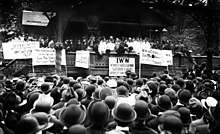
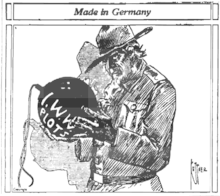
.jpg)
The IWW's efforts were met with "unparalleled" resistance from Federal, state and local governments in America;[7] from company management and labor spies, and from groups of citizens functioning as vigilantes. In 1914, Wobbly Joe Hill (born Joel Hägglund) was accused of murder in Utah and, on what many regarded as flimsy evidence, was executed in 1915.[43][44] On November 5, 1916, at Everett, Washington, a group of deputized businessmen led by Sheriff Donald McRae attacked Wobblies on the steamer Verona, killing at least five union members[45] (six more were never accounted for and probably were lost in Puget Sound). Two members of the police force — one a regular officer and another a deputized citizen from the National Guard Reserve — were killed, probably by "friendly fire".[46] At least five Everett civilians were wounded.[47]
Many IWW members opposed United States participation in World War I. The organization passed a resolution against the war at its convention in November 1916.[48]:241 This echoed the view, expressed at the IWW's founding convention, that war represents struggles among capitalists in which the rich become richer, and the working poor all too often die at the hands of other workers.
An IWW newspaper, the Industrial Worker, wrote just before the U.S. declaration of war: "Capitalists of America, we will fight against you, not for you! There is not a power in the world that can make the working class fight if they refuse." Yet when a declaration of war was passed by the U.S. Congress in April 1917, the IWW's general secretary-treasurer Bill Haywood became determined that the organization should adopt a low profile in order to avoid perceived threats to its existence. The printing of anti-war stickers was discontinued, stockpiles of existing anti-war documents were put into storage, and anti-war propagandizing ceased as official union policy. After much debate on the General Executive Board, with Haywood advocating a low profile and GEB member Frank Little championing continued agitation, Ralph Chaplin brokered a compromise agreement. A statement was issued that denounced the war, but IWW members were advised to channel their opposition through the legal mechanisms of conscription. They were advised to register for the draft, marking their claims for exemption "IWW, opposed to war."[48]:242–244
In spite of the IWW moderating its vocal opposition, the IWW's antiwar stance made it highly unpopular. Frank Little, the IWW's most outspoken war opponent, was lynched in Butte, Montana, in August 1917, just four months after war had been declared.
_cover.jpg)
During World War I the U.S. government moved strongly against the IWW. On September 5, 1917, U.S. Department of Justice agents made simultaneous raids on dozens of IWW meeting halls across the country.[31]:406 Minutes books, correspondence, mailing lists, and publications were seized, with the U.S. Department of Justice removing five tons of material from the IWW's General Office in Chicago alone.[31]:406 This seized material was scoured for possible violations of the Espionage Act of 1917 and other laws, with a view to future prosecution of the organization's leaders, organizers, and key activists.
Based in large measure on the documents seized September 5, one hundred and sixty-six IWW leaders were indicted by a Federal Grand Jury in Chicago for conspiring to hinder the draft, encourage desertion, and intimidate others in connection with labor disputes, under the new Espionage Act.[31]:407 One hundred and one went on trial en masse before Judge Kenesaw Mountain Landis in 1918. Their lawyer was George Vanderveer of Seattle.[49] They were all convicted — including those who had not been members of the union for years — and given prison terms of up to twenty years. Sentenced to prison by Judge Landis and released on bail, Haywood fled to the Russian Soviet Federative Socialist Republic where he remained until his death.
In 1917, during an incident known as the Tulsa Outrage, a group of black-robed Knights of Liberty tarred and feathered seventeen members of the IWW in Oklahoma. The attack was cited as revenge for the Green Corn Rebellion, a preemptive attack caused by fear of an impending attack on the oil fields and as punishment for not supporting the war effort. The IWW members had been turned over to the Knights of Liberty by local authorities after they were beaten, arrested at their headquarters and convicted of the crime of vagrancy. Five other men who testified in defense of the Wobblies were also fined by the court and subjected to the same torture and humiliations at the hands of the Knights of Liberty.[50][51][52][53][54]
| Wikisource has original text related to this article: |
In 1919, an Armistice Day parade by the American Legion in Centralia, Washington, turned into a fight between legionnaires and IWW members in which four legionnaires and a Centralia deputy sheriff were shot dead. Which side initiated the violence of the Centralia massacre is disputed. A number of IWWs were arrested, one of whom, Wesley Everest, was lynched by a mob that night.[55]
Members of the IWW were prosecuted under various State and federal laws and the 1920 Palmer Raids singled out the foreign-born members of the organization.
Organizational schism and afterwards
IWW quickly recovered from the setbacks of 1919 and 1920, with membership peaking in 1923 (58,300 estimated by dues paid per capita, though membership was likely somewhat higher as the union tolerated delinquent members).[56] But recurring internal debates, especially between those who sought either to centralize or decentralize the organization, ultimately brought about the IWW's 1924 schism.[57]
At the beginning of the 1949 Smith Act trials, FBI director J. Edgar Hoover was disappointed when prosecutors indicted fewer CPUSA members than he had hoped, and – recalling the arrests and convictions of over one hundred IWW leaders in 1917 – complained to the Justice Department, stating, "the IWW was crushed and never revived, similar action at this time would have been as effective against the Communist Party."
Activity after World War II
1950–2000
Taft–Hartley Act
After the passage of the Taft-Hartley Act in 1946 by Congress, which called for the removal of Communist union leadership, the IWW experienced a loss of membership as differences of opinion occurred over how to respond to the challenge. In 1949, US Attorney General Tom C. Clark[58] placed the IWW on the Attorney General's List of Subversive Organizations[59] in the category of "organizations seeking to change the government by unconstitutional means" under Executive Order 9835, which offered no means of appeal, and which excluded all IWW members from Federal employment and federally subsidized housing programs (this order was revoked by Executive Order 10450 in 1953).
At this time, the Cleveland local of the Metal and Machinery Workers Industrial Union (MMWIU) was the strongest IWW branch in the United States. Leading figures such as Frank Cedervall, who had helped build the branch up for over ten years, were concerned about the possibility of raiding from AFL-CIO unions if the IWW had its legal status as a union revoked. In 1950, Cedervall led the 1500-member MMWIU national organization to split from the IWW, as the Lumber Workers Industrial Union had almost thirty years earlier. Unfortunately for the MMWIU, this act would not save it. Despite its brief affiliation with the Congress of Industrial Organizations, it would face serious raiding from AFL and CIO and would be defunct by the late 1950s, less than ten years after separating from the IWW.[60]
The loss of the MMWIU, at the time the IWW's largest industrial union, was almost a deathblow to the IWW. The union's membership fell to its lowest level in the 1950s during the Second Red Scare, and by 1955, the union's fiftieth anniversary, it was near extinction, though it still appeared on government lists of Communist-led groups.[61]
1960s rejuvenation
The 1960s civil rights movement, anti-war protests, and various university student movements brought new life to the IWW, albeit with many fewer new members than the great organizing drives of the early part of the 20th century.
The first signs of new life for the IWW in the 1960s would be organizing efforts among students in San Francisco and Berkeley, which were hotbeds of student radicalism at the time. This targeting of students would result in a Bay Area branch of the union with over a hundred members in 1964, almost as many as the union's total membership in 1961. Wobblies old and new would unite for one more "free speech fight": Berkeley's Free Speech Movement. Riding on this high, the decision in 1967 to allow college and university students to join the Education Workers Industrial Union (IU 620) as full members spurred campaigns in 1968 at the University of Waterloo in Ontario, the University of Wisconsin–Milwaukee, and the University of Michigan in Ann Arbor.[62]:13 The IWW would send representatives to Students for a Democratic Society conventions in 1967, 1968, and 1969, and as the SDS collapsed into infighting, the IWW would gain members who were fleeing this discord. These changes would have a profound effect on the union, which by 1972 would have sixty-seven percent of members under the age of thirty, with a total of nearly five hundred members.[62]:14
The IWW's links to the 60s counterculture led to organizing campaigns at counterculture businesses, as well as a wave of over two dozen co-ops affiliating with the IWW under its Wobbly Shop model in the 1960s to 1980s. These businesses were primarily in printing, publishing, and food distribution; from underground newspapers and radical print shops to community co-op grocery stores. Some of the printing and publishing industry co-ops and job shops included Black & Red (Detroit), Glad Day Press (New York),[62]:17 RPM Press (Michigan),[62]:17 New Media Graphics (Ohio),[62]:17 Babylon Print (Wisconsin),[62]:17 Hill Press (Illinois),[62]:17 Lakeside (Madison, Wisconsin), Harbinger (Columbia, South Carolina), Eastown Printing in Grand Rapids, Michigan (where the IWW negotiated a contract in 1978),[62]:17 and La Presse Populaire (Montréal). This close affiliation with radical publishers and printing houses sometimes led to legal difficulties for the union, such as when La Presse Populaire was shut down in 1970 by provincial police for publishing pro-FLQ materials, which were banned at the time under an official censorship law. Also in 1970, the San Diego, California, "street journal" El Barrio became an official IWW shop. In 1971 its office was attacked by an organization calling itself the Minutemen, and IWW member Ricardo Gonzalves was indicted for criminal syndicalism along with two members of the Brown Berets.[61]
These ties to anti-authoritarian and radical artistic and literary currents would link the IWW even more heavily to the 60s counterculture, exemplified by the publication in Chicago in the 1960s of Rebel Worker by the surrealists Franklin and Penelope Rosemont. One edition was published in London with Charles Radcliffe, who went on to become involved with the Situationist International. By the 1980s, the Rebel Worker was being published as an official organ again, from the IWW's headquarters in Chicago, and the New York area was publishing a newsletter as well.
Return to workplace campaigns
Invigorated by the arrival of enthusiastic new members, the IWW began a wave of organizing drives. These largely took a regional form and they, as well as the union's overall membership, concentrated in Portland, Chicago, Ann Arbor, and throughout the state of California, which when combined accounted for over half of union drives from 1970 to 1979. In Portland, Oregon, the IWW led campaigns at Winter Products (a brass plating plant) in 1972, at a local Winchell's Donuts (where a strike was waged and lost), at the Albina Day Care (where key union demands were won, including the firing of the director of the day care), of healthcare workers at West Side School and the Portland Medical Center, and of agricultural workers in 1974. The latter effort led to the opening of an IWW union hall in Portland to compete with extortionate hiring halls and day labor agencies. Organizing efforts led to a growth in membership, but repeated loss of strikes and organizing campaigns would anticipate the decline of the Portland branch after the mid-1970s, a stagnancy period which would last until the 1990s.[62]:15
In California, union activities were based in Santa Cruz, where in 1977 the IWW engaged in one of its most ambitious campaigns of the 1970s: an attempt in 1977 to organize 3,000 workers hired under the Comprehensive Employment and Training Act (CETA) in Santa Cruz County. The campaign led to pay raises, the implementation of a grievance procedure, and medical and dental coverage, but the union failed to maintain its foothold, and in 1982 the CETA program would be replaced by the Job Training Partnership Act.[62]:15–16 The IWW would win some lasting victories in Santa Cruz, however, with successful campaigns at the Janus Alcohol Recovery Center, the Santa Cruz Law Center, Project Hope, and the Santa Cruz Community Switchboard.[62]:16
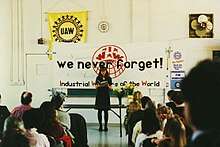
Elsewhere in California, the IWW was active in Long Beach in 1972, where it organized workers at International Wood Products and Park International Corporation (a manufacturer of plastic swimming pool filters) and went on strike after the firing of one worker for union-related activities.[63] Finally, in San Francisco, the IWW ran campaigns for radio station and food service workers.[62]:15–16
In Chicago, the IWW was an early opponent of so-called urban renewal programs, and supported the creation of the "Chicago People's Park" in 1969. The Chicago branch also ran citywide campaigns for healthcare, food service, entertainment, construction, and metal workers, and its success with the latter led to an attempt to revive the national Metal and Machinery Workers Industrial Union, which twenty years earlier had been a major component of the union. Metalworker organizing would largely end in 1978 after a failed strike at Mid-American Metal in Virden, Illinois. The IWW also became one of the first unions to try to organize fast food workers, with an organizing campaign at a local McDonald's in 1973.[62]:16
The IWW also built on its existing presence in Ann Arbor, which had existed since student organizing began at the University of Michigan, to launch an organizing campaign at the University Cellar, a college bookstore. The union won National Labor Relations Board (NLRB) certification there in 1979 following a strike, and the store would become a strong job shop for the union until it was closed in 1986. The union launched a similar campaign at another local bookstore, Charing Cross Books, but was unable to maintain its foothold there despite reaching a settlement with management.[62]:17
In the late 1970s, the IWW came to regional prominence in entertainment industry organizing, with an Entertainment Workers Organizing Committee being founded in Chicago in 1976, followed by campaigns organizing musicians in Cleveland in 1977 and Ann Arbor in 1978. The Chicago committee published a model contract which was distributed to musicians in the hopes of raising industry standards, as well as maintaining an active phone line for booking information. IWW musicians such as Utah Phillips, Faith Petric, Bob Bovee, and Jim Ringer also toured and promoted the union,[62]:17 and in 1987 an anthology album, Rebel Voices, was released.
Other IWW organizing campaigns of the 1970s included a ShopRite supermarket in Milwaukee, at Coronet Foods in Wheeling, West Virginia, chemical and fast food workers (including KFC and Roy Rogers) in State College, Pennsylvania, and hospital workers in Boston, all in 1973; shipyards in Houston, Texas, and restaurant workers in Pittsburgh in 1974; unsuccessful campaigns at the Prospect Nursing Home in Cambridge, Massachusetts, and a Pizza Hut in Arkadelphia, Arkansas, in 1975; and a construction workers organizing drive in Albuquerque, New Mexico, in 1978.[62]:18
1990s
In the 1990s, the IWW was involved in many labor struggles and free speech fights, including Redwood Summer, and the picketing of the Neptune Jade in the port of Oakland in late 1997.
In 1996, the IWW launched an organizing drive against Borders Books in Philadelphia. In March, the union lost an NLRB certification vote by a narrow margin but continued to organize. In June, IWW member Miriam Fried was fired on trumped-up charges and a national boycott of Borders was launched in response. IWW members picketed at Borders stores nationwide, including Ann Arbor; Washington, D.C.; San Francisco; Miami; Chicago; Palo Alto; Portland, OR; Portland, ME; Boston; Philadelphia; Albany; Richmond; St. Louis; Los Angeles; and other cities. This was followed up with a National Day of Action in 1997, where Borders stores were again picketed nationwide, and a second organizing campaign in London, England.[64]
Also in 1996, the IWW began organizing at Wherehouse Music in El Cerrito, California. The campaign continued until 1997, when management fired two organizers and laid off over half the employees, as well as reducing the hours of known union members. This directly affected the NLRB certification vote which followed, where the IWW lost over 2:1.[64]
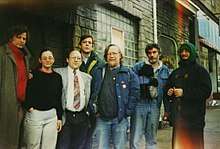
In 1998, the IWW chartered a San Francisco branch of the Marine Transport Workers Industrial Union (MTWIU), which trained hundreds of waterfront workers in health and safety techniques and attempted to institutionalize these safety practices on the San Francisco waterfront.[65]
In 1999, the IWW chartered a local branch of the Education Workers Industrial Union in Boston, Massachusetts, which started to organize workers at local colleges and universities.
Additionally, IWW organizing drives in the late 90s included a strike at the Lincoln Park Mini Mart in Seattle in 1996, Keystone Job Corps, the community organization ACORN, various homeless and youth centers in Portland, Oregon, sex industry workers, and recycling shops in Berkeley, California. IWW members were also active in the building trades, shipyards, high tech industries, hotels and restaurants, public interest organizations, railroads, bike messengers, and lumber yards.
The IWW stepped in several times to help the rank and file in mainstream unions, including saw mill workers in Fort Bragg in California in 1989, concession stand workers in the San Francisco Bay Area in the late 1990s, and shipyards along the Mississippi River.
2000–2010
In the early 2000s, the IWW organized Stonemountain and Daughter Fabrics, a fabric shop in Berkeley, California. The shop continues to remain an IWW organized shop.
The city of Berkeley's recycling is picked up, sorted, processed and sent out all through two different IWW-organized enterprises.
In 2003, the IWW began organizing street people and other non-traditional occupations with the formation of the Ottawa Panhandlers Union. A year later, the Panhandlers Union led a strike by the homeless. Negotiations with the city resulted in the city government promising to fund a newspaper written and sold by the homeless.
Between 2003 and 2006, the IWW organized unions at food co-operatives in Seattle, Washington and Pittsburgh, Pennsylvania. The IWW represents administrative and maintenance workers under contract in Seattle, while the union in Pittsburgh lost 22–21 in an NLRB election, only to have the results invalidated in late 2006, based on management's behavior before the election.
In 2004, an IWW union was organized in a New York City Starbucks. In 2006, the IWW continued efforts at Starbucks by organizing several Chicago area shops.[68][69]
In Chicago the IWW began an effort to organize bicycle messengers with some success.
In September 2004, IWW-organized short haul truck drivers in Stockton, California walked off their jobs and went on a strike. Nearly all demands were met. Despite early victories in Stockton, the truck driver union ceased to exist in mid-2005.
In New York City, the IWW has been organizing immigrant foodstuffs workers since 2005. That summer, workers from Handyfat Trading joined the IWW, and were soon followed by workers from four more warehouses.[70] Workers at these warehouses made gains such as receiving the minimum wage and being paid overtime.
In 2006, the IWW moved its headquarters to Cincinnati, Ohio, and in 2010, headquarters was moved back to Chicago, Illinois.
Also in 2006, the IWW Bay Area Branch organized the Landmark Shattuck Cinemas. The Union has been negotiating for a contract and hopes to gain one through workplace democracy and organizing directly and taking action when necessary.
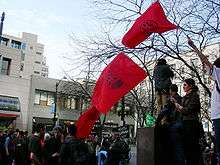
— Staughton Lynd, 2014.[71]
In May 2007, the NYC warehouse workers came together with the Starbucks Workers Union to form The Food and Allied Workers Union IU 460/640. In the summer of 2007, the IWW organized workers at two new warehouses: Flaum Appetizing, a Kosher food distributor, and Wild Edibles, a seafood company. Over the course of 2007–08, workers at both shops were illegally terminated for their union activity. In 2008, the workers at Wild Edibles actively fought to get their jobs back and to secure overtime pay owed to them by the boss. In a workplace justice campaign called Focus on the Food Chain, carried out jointly with Brandworkers International, the IWW workers won settlements against employers including Pur Pac, Flaum Appetizing and Wild Edibles.[72][73][74][75]
Besides IWW's traditional practice of organizing industrially, the Union has been open to new methods such as organizing geographically: for instance, seeking to organize retail workers in a certain business district, as in Philadelphia.
The union has also participated in such worker-related issues as protesting involvement in the war in Iraq, opposing sweatshops and supporting a boycott of Coca-Cola for that company's support of the suppression of workers rights in Colombia.
On July 5, 2008, the Grand Rapids, Michigan, Starbucks Workers Union and CNT-AIT in Seville, Spain, organized a global day of action against alleged Starbucks union busting, in particular the firing of two union members in Grand Rapids and Seville. According to the Grand Rapids Starbucks Workers Union website,[76] pickets were held in several dozen cities in more than a dozen countries.
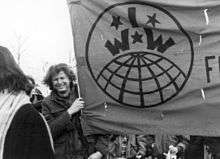
The Portland, Oregon General Membership Branch is one of the largest and most active branches of the IWW currently. The branch holds three contracts currently, two with Janus Youth Programs and one with Portland Women's Crisis Line.[77] There has been some debate within the branch about whether or not union contracts such as this are desirable in the long run, with some members favoring solidarity unionism as opposed to contract unionism and some members believing there is room for both strategies for organizing. The branch has successfully supported workers wrongfully fired from several different workplaces in the last two years. Due to picketing by Wobblies, these workers have received significant compensation from their former employers. Branch membership has been increasing, as has shop organizing. As of 2005, the 100th anniversary of its founding, the IWW had around 5,000 members, compared to 13 million members in the AFL-CIO.[78] Other IWW branches are located in Australia, Austria, Canada, Ireland, Germany, Uganda and the United Kingdom.
2011 Wisconsin General Strike
In early 2011, Wisconsin Governor Scott Walker announced a budget bill which the IWW held would effectively outlaw unions for state or municipal workers. In response, there was an emergency meeting of the Midwestern IWW member organizations. The participants decided that organizing a general strike was an absolute priority. IWW members presented a proposal at a meeting of South-Central Federation of Labor (SCFL) which would endorse a general strike and create an ad-hoc Committee to instruct affiliated locals in preparations for the general strike. The IWW proposal passed nearly unanimously. The Madison branch made an international appeal translating various materials concerning the strike into Arabic, French, Spanish, Italian and Portuguese. Additionally, an appeal was made to European unions (CNT – Spain, CGT – Spain and CGT – France) to send organizers to Madison who could present their experience of general strikes at union meetings and help organize the strike in other ways. The CNT (France) sent letters of solidarity to the IWW. This was considered the largest and most successful intervention in a working-class struggle that the IWW has undertaken since the 1930s.[79] In the aftermath, the strike was said by some to be 'The General Strike that didn't happen' because eventually ongoing efforts at industrial action were "completely overwhelmed by the recall effort" against the governor during the crisis.[80]
Since 2012
In 2012, the IWW moved its General Headquarters offices to 2036 West Montrose, Chicago.[13]
The IWW has seen rapid growth since 2012, particularly since 2017, the union's US membership numbers as of 2020 were at the highest they had been since the 1940s. Many of the union's campaigns are "underground" and are not known outside of the union's spaces. The contemporary IWW has however been involved in several high profile bouts with employers and have been part of organizing large-scale actions in more recent years. Although the IWW still organizes in every sector of employment they have enjoyed the most success among education and food service workers.
For example, the IWW waged an organizing campaign at Chicago-Lake Liquors in Minneapolis, Minnesota in 2013. The store, which advertises itself as the highest-volume liquor store in Minnesota, had a wage cap of $10.50 per hour, but in the face of IWW demands for the wage cap to be lifted, store management fired five organizers. On April 6, the Twin Cities branch of the union responded with a picket around the store informing customers of the situation. This was followed by a second picket on May 4, a day which customarily had heavy business at the store. The union claimed to have made "what should have been an extremely busy Saturday into a quiet afternoon inside the store".[81] After several months, the National Labor Relations Board announced that it found merit in the union's unfair dismissal complaint.[82] As a result, the union and store management agreed to a $32,000 settlement as a form of compensation to the fired workers and the campaign officially ended.
Workers at the Paulo Freire Social Justice Charter School in Holyoke, Massachusetts were organized with the IWW in 2015, hoping to address the "authoritarian leadership" of the school administration and perceived racial bias in hiring.[83]
On 14 September 2015, after a year long organizing campaign, workers at Sound Stage Production in North Haven Connecticut declared their membership in the IWW.[84] Within a week they were threatened with legal action and fired. After several months of negotiation through the National Labor Relations Board, a settlement was reached and the workers agreed to back pay and severance compensation. As part of the campaign, the workers formed the Production Services Collective and continue as a workers cooperative and organizing with IWW-CT.
The IWW announced the Burgerville Workers Union (BVWU) in April 2016, which focuses on workers at the Oregon regional fast food chain, Burgerville. A subsidiary of the IWW, the BVWU went public on April 26 at a rally of workers and supporters outside a Portland, Oregon Burgerville location. Upon going public, the BVWU was endorsed by a number of local Oregon community organizations, including union locals, the Portland Solidarity Network, and food and racial justice organizations.[85] It was also endorsed by then-Democratic presidential candidate Senator Bernie Sanders (I-Vt.). The union received pushback with a letter from Burgerville's CEO, Jeff Harvey, being distributed to workers discouraging them from joining the union.[86] In June 2017, Burgerville paid a settlement of $10,000 after an investigation by the Oregon Bureau of Labor and Industries, which found that the company had violated state-mandated break periods for workers.[87] In April and May 2018 the IWW won NLRB elections in 2 Burgerville Locations.
In August 2016, workers at Ellen's Stardust Diner in Manhattan formed Stardust Family United (SFU) under the IWW, driven by the firing of thirty employees, as well as an unpopular new scheduling system.[88] After going public, the union accused Stardust management of retaliatory firings and posting anti-union materials in the restaurant.[89]
On 9 September 2016, the 45th anniversary of the Attica Prison Riots, 900[90] incarcerated workers organized by the IWW and many other prisoners participated in the 9/9 National Prison Strike declared by the IWW's Incarcerated Workers Organizing Committee. Supported by a number of anti-incarceration and prisoners' organizations such as the Free Alabama Movement, the strike focused on the poor conditions in many American prisons and the low rates of prisoner pay for maintaining prisons and engaging in commercial production of goods for third-party companies.[91] The strike affected an estimated twenty[92] prisons in eleven states and was strongest at the William C. Holman Correctional Facility in Alabama.[92] Estimates of the number of inmates affected range from 20,000,[92] to 50,000,[93] to as high as 72,000,[94] with David Fathi of the ACLU National Prison Project judging it to be the "largest prisoner strike in recent memory".[92] Initial media coverage was slow, with strike organizers complaining of a "mainstream-media blackout", which could be attributed to the difficulty in communicating with prisoners, as many prisons went on lockdown either in response to prisoner strike activity or in anticipation of it.[90]
The IWW has also been organizing workers during the COVID-19 pandemic in the United States, such as with the May 2020 establishment of the Voodoo Doughnut Workers Union (VWU) in Oregon. According to Al Jazeera, "the newly formed union delivered a letter to management announcing the formation of a union and demanding higher wages, safety improvements and severance packages for employees laid off because of the coronavirus and Oregon's ongoing "shelter-in-place" order." The article said this is considered a deviation from more traditional union tactics and may serve as a blueprint for how workers respond to COVID-19 related issues on the job.[95] The IWW also publicly announced the Second Staff (2S) workers union in May of 2020 at the Faison school, a private school serving students on the autism spectrum in Richmond, VA in response to what the union called a "reckless"endangerment of staff and students" in trying to force the school to open too soon.[96]
Internationally
Australia
Australia encountered the IWW tradition early. In part this was due to the local De Leonist Socialist Labor Party following the industrial turn of the US SLP. The SLP formed an IWW Club in Sydney in October 1907. Members of other socialist groups also joined it, and the special relationship with the SLP soon proved to be a problem. The 1908 split between the Chicago and Detroit factions in the United States was echoed by internal unrest in the Australian IWW from late 1908, resulting in the formation of a pro-Chicago local in Adelaide in May 1911 and another in Sydney six months later. By mid-1913 the "Chicago" IWW was flourishing and the SLP-associated pro-Detroit IWW Club in decline.[97] In 1916 the "Detroit" IWW in Australia followed the lead of the US body and renamed itself the Workers' International Industrial Union.[98]
The early Australian IWW used a number of tactics from the US, including free speech fights. However, there early appeared significant differences of practice between the Australian IWW and its US parent; the Australian IWW tended to co-operate where possible with existing unions rather than forming its own, and in contrast with the US body took an extremely open and forthright stand against involvement in World War One. The IWW cooperated with many other unions, encouraging industrial unionism and militancy. In particular, the IWW's strategies had a large effect on the Australasian Meat Industry Employees Union. The AMIEU established closed shops and workers councils and effectively regulated management behaviour toward the end of the 1910s.
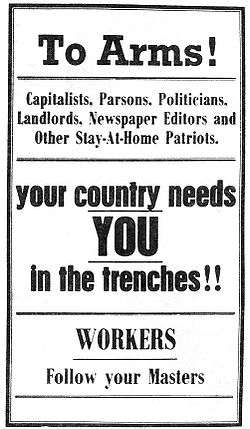
The IWW was well known for opposing the First World War from 1914 onwards, and in many ways was at the front of the anti-conscription fight. A narrow majority of Australians voted against conscription in a very bitter hard-fought referendum in October 1916, and then again in December 1917, Australia being the only belligerent in World War One without conscription. In very significant part this was due to the agitation of the IWW, a group which probably never had as many as 500 members in Australia at its peak. The IWW founded the Anti-Conscription League (ACL) in which members worked with the broader labour and peace movement, and also carried on an aggressive propaganda campaign in its own name; leading to the imprisonment of Tom Barker (1887–1970) the editor of the IWW paper Direct Action, sentenced to twelve months in March 1916. A series of arson attacks on commercial properties in Sydney was widely attributed to the IWW campaign to have Tom Barker released. He was indeed released in August 1916, but twelve mostly prominent IWW activists, the so-called Sydney Twelve were arrested in NSW in September 1916 for arson and other offences. (Their trial and eventual imprisonment would become a cause célèbre of the Australian labour movement on the basis that there was no convincing evidence that any of them had been involved in the arson attacks.) A number of other scandals were associated with the IWW, a five-pound note forgery scandal, the so-called Tottenham tragedy in which the murder of a police officer was blamed on the IWW, and above all it was blamed for the defeat of the October 1916 conscription referendum. In December 1916 the Commonwealth government led by Labour Party renegade Billy Hughes declared the IWW an illegal organization under the Unlawful Associations Act. Eighty six members immediately defied the law and were sentenced to six months imprisonment. Direct Action was suppressed, its circulation was at its peak of something over 12,000.[99] During the war over 100 members Australia-wide were sentenced to imprisonment on political charges,[100] including the veteran activist Monty Miller.
The IWW continued illegally operating with the aim of freeing its class war prisoners and briefly fused with two other radical tendencies – from the old Socialist parties and Trades Halls – to form a larval communist party at the suggestion of the militant revolutionist and Council Communist Adela Pankhurst. The IWW, however, left the CPA shortly after its formation.
By the early 1930s, most Australian IWW branches had dispersed as the Communist Party grew in influence.[101]
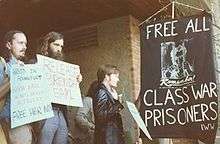
The Australian IWW has grown since the 1940s, but due to the nature of the Australian industrial relations system, it is unlikely to win union representation in any workplaces in the immediate future. More significant is its continuing place in the mythology of the militant end of the Australian labour movement.[102] As an extreme example of the integration of ex-IWW militants into the mainstream labour movement one might instance the career of Donald Grant, one of the Sydney Twelve sentenced to fifteen years imprisonment for conspiracy to commit arson and other crimes. Released from prison in August 1920 he would soon break with the IWW over its anti-political stand, standing for the NSW Parliament for the Industrial Socialist Labour Party unsuccessfully in 1922 and then in 1925 for the mainstream Australian Labor Party (ALP) also unsuccessfully. However, this reconciliation with the ALP and the electoral system did not prevent him being imprisoned again in 1927 for street demonstrations supporting Sacco and Vanzetti. He would eventually represent the ALP in the NSW Legislative Council in 1931–1940 and the Australian Senate 1943–1956.[103] No other member of the Australian IWW actually entered Parliament but Grant's career is emblematic in the sense that the ex-IWW militants by and large remained in the broader labour movement, bringing some greater or lesser part of their heritage with them.
"Bump Me Into Parliament"[104] is the most notable Australian IWW song, and is still current. It was written by ship's fireman William "Bill" Casey, later Secretary of the Seaman's Union in Queensland.[99]
New Zealand
Australian influence was strong in early 20th century left-wing groups, and several founders of the New Zealand Labour Party (e.g. Bob Semple) were from Australia. The trans-Tasman interchange was two-way, particularly for miners. Several Tasmanian Labour "groupings" in the 1890s cited their earlier New Zealand experience of activism e.g. later premier Robert Cosgrove, and also Chris Watson from New South Wales.[105]
"Wobbly" activists in New Zealand pre-WWI were John Benjamin King and H. M. Fitzgerald (an adherent of the De Leon school) from Canada. Another was Robert Rivers La Monte from America, who was (briefly) an organiser for the New Zealand Socialist Party (as was Fitzgerald). IWW strongholds were Auckland "a city with the demographic characteristics of a frontier town"; Wellington where a branch survived briefly and in mining towns, on the wharves and among labourers.[106]
Canada
The IWW was active in Canada from a very early point in the organization's history, especially in Western Canada, primarily in British Columbia. The union was active in organizing large swaths of the lumber and mining industry along the coast, in the Interior of BC, and Vancouver Island. Joe Hill wrote the song "Where the Fraser River Flows" during this period when the IWW was organizing in British Columbia. Some members of the IWW had relatively close links with the Socialist Party of Canada.[107] Canadians who went to Australia and New Zealand before WWI included John Benjamin King and H. M. Fitzgerald (an adherent of the De Leon school).[106]
Arthur "Slim" Evans, organizer in the Relief Camp Workers' Union and the On-to-Ottawa Trek of 1935 was once a Wobbly, although during the On-to-Ottawa Trek he was with the One Big Union. He was also a friend of another well-known Canadian, Ginger Goodwin, who was shot in Cumberland, British Columbia by a Dominion Police constable when he was resisting the First World War. The impact of Ginger Goodwin influenced various left and progressive groups in Canada, including a progressive group of MPs in the House of Commons called the Ginger Group.
Despite the IWW being banned as a subversive organization in Canada during the First World War, the organization rebounded swiftly after being unbanned after the war, reaching a post-WWI high of 5600 Canadian members in 1923.[108] The union entered a short "golden age" in Canada with an official Canadian Administration located at the Finnish Labour Temple in Port Arthur (now Thunder Bay, Ontario) and a strong base among immigrant labourers in Northern Ontario and Manitoba, especially Finns, which included harvest workers, lumberjacks, and miners. During this period, the IWW would compete for members with a number of other radical and socialist organizations such as the Finnish Organization of Canada (FOC), with the IWW's Industrialisti newspaper competing with the FOC's Vapaus for attention and readership. During this period. Membership slowly decreased during the 1920s and 30s despite continued organizing and strike activity as the IWW lost ground to the One Big Union and Communist Party-controlled organizations such as the Workers' Unity League (WUL). Despite this competition, the IWW and WUL cooperated during strikes, such as at the Abitibi Pulp & Paper Company near Sault Ste. Marie in 1933, where the Finnish workers in the IWW and WUL faced discrimination and violence from the Anglo citizens of the town. The IWW also successfully unionized Ritchie's Dairy in Toronto and formed a fishery workers' branch in MacDiarmid (now Greenstone, Ontario).[109]
In 1936, the IWW in Canada supported the Spanish Revolution and began to recruit for the militia of the anarcho-syndicalist Confederación Nacional del Trabajo (CNT), in direct conflict with Communist Party recruiters for the Mackenzie-Papineau Battalion, a conflict which resulted in a number of violent clashes at recruitment rallies in Northern Ontario. Several Canadian IWW members were killed in the Spanish Civil War and the CNT's ensuing defeat at the hands of both Fascist and Stalinist forces.[109] By the middle of the Second World War, IWW membership had dropped to 500, but had rebounded to 2000 by 1946. After this, the IWW entered a long period of decline, with the Canadian Administration slowly shrinking back to its traditional strongholds in Port Arthur and Vancouver, and becoming more of a social club and mutual aid society of mostly Finnish members in Port Arthur and the co-operative businesses they controlled. An Education Workers Industrial Union branch was established at the University of Waterloo in 1968, but failed to achieve success and dissolved. As well, in 1970 La Presse Populaire du Montréal, an IWW-run print shop, was shut down under the War Measures Act due to its support for the FLQ during the October Crisis. As a sign of the times, the old Canadian Administration in Port Arthur was dissolved in 1973 and replaced by a Canadian Regional Organizing Committee, meaning that Canadian branches would be administrated by the General Administration in the United States. IWW activity in Canada began to shift largely toward strike support and labour activism, such as support for the Artistic Woodwork strike in Toronto in 1974. By the 80s, the Vancouver branch was supporting unemployed activism through the Vancouver Unemployed Action Centre by helping to shut down the scam operation Vancouver Job Mart and supporting the campaign for a fixed-income transit pass.
By the end of the 1990s, the IWW in Canada was following the general pattern of ascendancy, winning government recognition at Harvest Collective in Manitoba, the first shop certified in Canada since 1919. During the 2000s, branches were chartered in several new cities, and existing branches were revitalized. The dissolved Canadian Regional Organizing Committee was refounded in 2011.
In 2009, after Starbucks established policies that would mean demotions and loss of salary for some workers, the Quebec branches of Montreal and Sherbrooke helped found the Starbucks Workers' Union (STTS) which made a breakthrough in Quebec City at an establishment in Sainte-Foy.[110] Leaders Simon Gosselin, Dominic Dupont and Andrew Fletcher were harassed in the months following unionization, and union efforts were defeated by law firm Heenan Blaike in the series of hearings before Quebec Labor Relations Board.[111] Following this episode and judging that the place of a wobblie is on the floor of his workplace and not in a court room, the local decided, once and for all, to abandon the consultation syndicalism of the Commission of labor relations to put forward a para-legal practice with solidarity syndicalism and direct action. This decision was confirmed at the 2011 IWW International Convention where the representatives agreed that no union affiliated with the IWW could sign a contract questioning its right to strike.[112] The result of those tactics provided very good results and Starbucks management backed up on their new policies even though the union process was officially over.
Today the IWW remains active in the country with branches in Vancouver, Vancouver Island, Edmonton, Winnipeg, Ottawa/Outaouais, Toronto, Windsor, Sherbrooke, Québec City and Montréal.[113] In August 2009, Canadian members voted to ratify the constitution of the Canadian Regional Organizing Committee (CanROC) to improve inter-branch coordination and communication. Affiliated branches are Winnipeg, Ottawa-Outaouais, Toronto, Windsor, Sherbrooke, Montréal and Québec City. Each branch elects a representative to make decisions on the Canadian board. There were originally three officers, the Secretary-Treasurer, Organizing Department Liaison, and Editor of the Canadian Organizing Bulletin.[114] In 2016, CanROC members voted to split the Secretary-Treasurer role into separate Regional Secretary and Regional Treasurer positions.
There are currently five job shops in Canada: Libra Knowledge and Information Services Co-op in Toronto, ParIT Workers Cooperative in Winnipeg, the Windsor Button Collective, the Ottawa Panhandlers' Union and the Street Labourers of Windsor (SLOW). The Ottawa Panhandlers' Union continues a tradition in the IWW of expanding the definition of worker. The union members include anyone who makes their living in the street, including buskers, street vendors, the homeless, scrappers and panhandlers. In the summer of 2004, the Union led strike by the Homeless (the Homeless Action Strike) in Ottawa. The strike resulted in the city agreeing to fund a newspaper created and sold by the Homeless on the street. On May 1, 2006, the Union took over the Elgin Street Police Station for a day. A similar IWW organization, the Street Labourers of Windsor (SLOW), has garnered local,[115] provincial,[116] and national[117] news coverage for its organizing efforts in 2015.
Recently, the IWW has also engaged in campaigns among harm reduction workers (resulting in the Toronto Harm Reduction Workers Union in 2014) and workers at the Québec fast food chain Frite Alors! in 2016.
Montreal
The largest Canadian General Membership Branch of the IWW is located in Montréal, Québec, where it officially operates under the name of Syndicat Industriel des Travailleurs et Travailleuses de Montréal (IWW-SITT).[118]
Media
Between 2015 - 2017, the IWW-SITT hosted a radio program titled Action en Direct (Direct Action) which was broadcast from Radio Centre-Ville 102.3FM[119] before moving to CHOQ radio at the Université du Québec à Montréal and being placed on hiatus.
Union Locals
The IWW-SITT maintains several active union locals in Montreal, including a freelancers union (Syndicat Associatif des Travailleurs-euses Autonome du Québec),[120] and a union for employees of student union, and student-union owned enterprises (Les travailleurs et les travailleuses des milieux associatifs en éducation).[121][122]
Europe
Germany, Luxembourg, Switzerland, Austria
The IWW started to organise in Germany following the First World War. Fritz Wolffheim played a significant role in establishing the IWW in Hamburg. A German Language Membership Regional Organizing Committee (GLAMROC) was founded in December 2006 in Cologne. It encompasses the German-language area of Germany, Luxembourg, Austria, and Switzerland with branches or contacts in 16 cities.[123] In 2015, the GLAMROC is reported as having 200 members in good standing[124]
Wales, Ireland, Scotland, England
The regional body of the union in the United Kingdom and Republic of Ireland is the Wales, Ireland, Scotland, England Regional Administration (WISERA). Formerly known as the Britain and Ireland Regional Administration (BIRA), its name was changed as a result of a referendum vote by WISERA members.[125]
Early history
The British Advocates of Industrial Unionism, founded in 1906, supported the IWW. This group split in 1908, with the majority supporting Daniel De Leon and a minority supporting E. J. B. Allen founding the Industrialist Union and developing links with the Chicago-based IWW. Allen's group soon disappeared, but the first IWW group in Britain was founded by members of the Industrial Syndicalist Education League led by Guy Bowman in 1913.
The IWW was present, to varying extents, in many of the struggles of the early decades of the 20th century, including the UK General Strike of 1926 and the dockers' strike of 1947. A Neath Wobbly, who had been active in Mexico, trained volunteers in preparation for the journey to Spain. There, they joined the International Brigade to fight against Franco, but did not return.
During the decade after World War II, the IWW had two active branches in London and Glasgow. These soon died off, before a modest resurgence in northwest England during the 1970s.
Membership
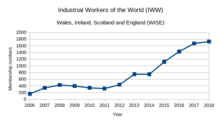
Between 2001 and 2003, there was a marked increase in UK membership, with the creation of the Hull General Membership Branch. During this time the Hull branch had 27 members of good standing; at that time the largest branch outside of the United States. By 2005, there were around 100 members in the United Kingdom. For the IWW's centenary, a stone was laid (51°41'598N 4°17.135W Geocacher), in a public access forest in Wales, commemorating the centenary of the union. As well, Sequoias were planted as a memorial to US IWW and Earth First! activist Judi Bari. 2006 saw the IWW formally registered by the UK government as a recognised trade union.
The IWW currently has a presence in several major urban areas as well as regional centres, with chartered branches in London, Glasgow (Clydeside GMB), Bradford, Bristol, Dorset, Edinburgh, Ireland, Leeds, Leicestershire, Manchester, Northamptonshire and Warwickshire, Northumbria, Nottingham, Reading, Sheffield, Wales, in the Tyne and Wear and West Midlands areas.
Overall, membership has increased rapidly; in 2014, the union reported a total UK membership of 750,[126] which increased to 1000 by April 2015.[127] In 2016, the 1,500 member limit was passed.
Campaigns
IWW members were involved in the Liverpool dockers' strike that took place between 1995 and 1998, and numerous other events and struggles throughout the 1990s and 2000s, including the successful unionising of several workplaces, such as support workers for the Scottish Socialist Party.
Recently, the IWW has focused its efforts on health and education workers, publishing a national industrial newsletter for health workers and a specific bulletin for workers in the National Blood Service. In 2007 it launched a campaign alongside the anti-capitalist group No Sweat which attempted to replicate some of the successes of the US IWW's organising drives amongst Starbucks workers. In the same year its health-workers' network launched a national campaign against cuts in the National Blood Service, which is ongoing.
Also in 2007, IWW branches in Glasgow and Dumfries were a key driving force in a successful campaign to prevent the closure of one of Glasgow University's campuses, (The Crichton) in Dumfries.[128] The campaign united IWW members, other unions, students and the local community to build a powerful coalition. Its success, coupled with the National Blood Service campaign, has raised the IWW's profile significantly since then.
In 2011, the IWW representing cleaners at the Guildhall won back-pay and the right to collective negotiation with their employers, Ocean. Also in 2011, branches of the IWW were set up in Lincoln, Manchester and Sheffield (notably workers employed by Pizza Hut).
The Edinburgh General Membership Branch of the IWW along with other branches of the IWW's Scottish section voted in 2014 to become a signatory to the "From Yes to Action Statement" produced by the Autonomous Centre of Edinburgh. In 2015, along with similar groups such as the Edinburgh Coalition Against Poverty and Edinburgh Anarchist Federation, they joined the Scottish Action Against Austerity network.[129]
In 2016, WISERA promoted a campaign targeting couriers working for companies such as Deliveroo.[130]
Elsewhere in Europe
An Iceland Regional Organizing Committee (IceROC) was chartered in 2015. The union has become a trailblazer in supporting sex workers in Iceland, who lack access to services which do not automatically treat them as victims of abuse.[131] In particular, the IWW in Iceland has taken a strong position against the Swedish model of policing sex work, where sex workers are not criminalized but their customers are, and instead has argued in favour of "organizing all workers without moral or legal judgement".[132]
Also in 2015, a Greek Regional Organizing Committee (GreROC) was chartered. In July of that year, it released a statement condemning the Greek government's response to the results of the 2015 Greek bailout referendum, saying that "despite the Left tone of dignity that the Left governmental administrators use, this is a one-way blackmail. We need a radical change of shift, not in words but in action."[133]
Africa
South Africa
The IWW has a rich and complex history in South Africa, with an original South African IWW organization being founded in 1910 and existing through most of the 1910s until disintegrating by around 1916.[134] The union's insistence on multiracial unionism set it at odds with the white trade union movement and brought severe political repression from the apartheid-era South African government. The major South African port of Durban was an important link in the IWW's international network which was largely maintained by its Marine Transport Workers Industrial Union, that connected the mainline North American IWW to ports in Africa, India, South America, and Australasia.
After the collapse of the formal IWW organization in South Africa, it would be succeeded by an Industrial Socialist League, the Industrial Workers of Africa, and finally the Industrial and Commercial Workers' Union (ICU), which would become the major black union in South Africa in the 1920s and 30s. Nevertheless, IWW and syndicalist influences would decline as the black workers' movement was brought into the trade union fold and came under the domination of the Communist Party of South Africa, which opposed syndicalist tendencies in the unions.[135]
Almost a hundred years later, multiple attempts were made to rebuild the South African IWW, with a short-lived South African Regional Organising Committee being founded in the early 2000s in Durban and attempts made to build a branch in Cape Town in the early 2010s, with neither resulting in success.[136]
Elsewhere in Africa
In 1997, there was a total of 3,240[137] workers in Sierra Leone, mostly miners, who registered themselves as IWW members in Sierra Leone government records largely independently of the international General Administration in Chicago (i.e. without the official issuing of membership cards or taking of dues). Contact between the Sierra Leone members and General Headquarters was lost after a military coup which was an episode in the Sierra Leone Civil War, which would last until 2002. The intensification of the civil war caused a number of IWW members, including the only official union delegate in the country, to flee to Guinea.[138][64]
In 2012, IWW members in Uganda formed a Ugandan Regional Organizing Committee (ROC) and began to raise funds to establish a Ugandan office for the IWW. However, it was discovered that the union officers in Uganda had been violating the Constitution of the IWW in multiple ways, such as by permitting employers to join the union, and the ROC was dissolved.[139]
Folk music and protest songs
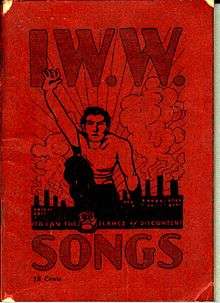
One Wobbly characteristic since their inception has been a penchant for song. To counteract management sending in the Salvation Army band to cover up the Wobbly speakers, Joe Hill wrote parodies of Christian hymns so that union members could sing along with the Salvation Army band, but with their own purposes. For example, "In the Sweet By and By" became "There'll Be Pie in the Sky When You Die (That's a Lie)". From that start in exigency, Wobbly song writing became common because they "articulated the frustrations, hostilities, and humor of the homeless and the dispossessed."[140] The IWW collected its official songs in the Little Red Songbook and continues to update this book to the present time. In the 1960s, the American folk music revival in the United States brought a renewed interest in the songs of Joe Hill and other Wobblies, and seminal folk revival figures such as Pete Seeger and Woody Guthrie had a pro-Wobbly tone, while some were members of the IWW. Among the protest songs in the book are "Hallelujah, I'm a Bum" (this song was never popular among members), "Union Maid", and "I Dreamed I Saw Joe Hill Last Night". Perhaps the best known IWW song is "Solidarity Forever". The songs have been performed by dozens of artists, and Utah Phillips performed the songs in concert and on recordings for decades. Other prominent IWW songwriters include Ralph Chaplin who authored "Solidarity Forever", and Leslie Fish.
The Finnish IWW community produced several folk singers, poets and songwriters, the most famous being Matti Valentine Huhta (better known as T-Bone Slim), who penned "The Popular Wobbly" and "The Mysteries of a Hobo's Life". Slim's poem, "The Lumberjack's Prayer" was recorded by Studs Terkel on labor singer Bucky Halker's Don't Want Your Millions. Hiski Salomaa, whose songs were composed entirely in Finnish (and Finglish), remains a widely recognized early folk musician in his native Finland as well as in sections of the Midwest United States, Northern Ontario, and other areas of North America with high concentrations of Finns. Salomaa, who was a tailor by trade, has been referred to as the Finnish Woody Guthrie. Arthur Kylander, who worked as a lumberjack, is a lesser known, but important Finnish IWW folk musician. Kylander's lyrics range from the difficulties of the immigrant labourer's experience to more humorous themes. Arguably, the wanderer, a recurring theme in Finnish folklore dating back to pre-Christian oral tradition (as with Lemminkäinen in the Kalevala), translated quite easily to the music of Huhta, Salomaa, and Kylander; each of whom have songs about the trials and tribulations of the hobo.
In literature
Much of the plot of the U.S.A. trilogy, a series of three novels by American writer John Dos Passos—comprising the novels The 42nd Parallel (1930), 1919 (1932), and The Big Money (1936)—is devoted to the IWW, and several of the more sympathetic characters are its members. Written at the time when Dos Passos was politically on the Left, the novels reflect the author's sympathy, at the time of writing, for the IWW and his outrage at its suppression, for which he expresses his deep grudge for President Woodrow Wilson.
Karl Marlantes's 2019 novel Deep River explores labor issues in the early 1900s in the US and the consequences for the an immigrant Finnish family. The book focuses on a female family member who becomes an organizer for the IWW in the dangerous logging industry. Both pro- and anti-labor viewpoints are examined, with special attention given to IWW strikes and the backlash against the labor movement during World War I.[141]
Lingo
Wobbly lingo is a collection of technical language, jargon, and historic slang used by the Wobblies, for more than a century. Many Wobbly terms derive from or are coextensive with hobo expressions used through the 1940s.[142][143] The origin of the name "Wobbly" itself is uncertain.[14][144][145] For several decades, many hobos in the United States were members of, or were sympathetic to, the IWW. Because of this, some of the terms describe the life of a hobo such as "riding the rails", living in "jungles", dodging the "bulls". The IWW's efforts to organize all trades allowed the lingo to expand to include terms relating to mining camps, timber work, and farming.[146][147]
Some words and phrases believed to have originated within Wobbly lingo have gained cultural significance outside of the IWW. For example, from Joe Hill's song "The Preacher and the Slave", the expression pie in the sky has passed into common usage, referring to a "preposterously optimistic goal".[148]
Notable members
Members of the Industrial Workers of the World have included:
- Roger Nash Baldwin, ACLU founder
- Judi Bari, labor and environmental organizer
- Harry Bridges (briefly, later helped form ILWU)
- James P. Cannon
- Lee J. Carter
- Ralph Chaplin
- Noam Chomsky
- James Connolly
- Carlos Cortez, graphic artist
- Dorothy Day, Catholic Worker
- Daniel De Leon
- Eugene V. Debs
- David Dellinger
- Sam Dolgoff
- Vincent R. Dunne
- Joseph Ettor
- Anne Feeney, folk musician
- Ben Fletcher
- Ricardo Flores Magón
- Elizabeth Gurley Flynn
- William Z. Foster
- Otis Gibbs, folk musician
- Arturo Giovannitti
- Lala Hardayal, Indian Nationalist
- Big Bill Haywood
- Howie Hawkins
- Ammon Hennacy, Catholic Worker
- Lesbia Harford, Australian poet
- Joe Hill
- Harry Hooton, Australian poet
- Mary Harris "Mother" Jones
- Andy Irvine, folk musician
- Rosie Kane, former Member of the Scottish Parliament
- Helen Keller[149]
- Jim Larkin
- Carolyn Leckie, former Member of the Scottish Parliament
- Frank Little
- Paul Mattick
- Harry McClintock, folk musician
- Kevin McCoy, artist
- Monty Miller
- Tom Morello
- Eugene O'Neill
- Floyd B. Olson, Minnesota Governor[150]
- Lucy Parsons
- Fredy Perlman
- Faith Petric, folk musician
- Utah Phillips, folk musician
- John Reed, journalist
- Kenneth Rexroth, counterculture icon
- Franklin Rosemont, Surrealist
- David Rovics, folk musician
- Hiski Salomaa, Finnish folk music singer
- Pete Seeger, American folk musician
- Gary Snyder, Buddhist beat poet
- Jim Thompson, crime writer
- Dave Van Ronk, folk musician
- Fritz Wolffheim
Former lieutenant governor of Colorado David C. Coates was a labor militant, and was present at the founding convention,[48]:242–78 although it is unknown if he became a member. It has long been rumored, but not yet proven, that baseball legend Honus Wagner was also a Wobbly. Senator Joe McCarthy accused Edward R. Murrow of having been an IWW member, which Murrow denied.[151] Some of the organization's most famous current members include Noam Chomsky, Tom Morello, mixed martial arts fighter Jeff Monson, and anthropologist David Graeber.
See also
- 1933 Yakima Valley strike
- Bérmunkás
- Centralia massacre
- Eugene V. Debs
- History of the Industrial Workers of the World
- Industrial democracy
- Industrial Workers of the World philosophy and tactics
- Labor federation competition in the United States
- List of Industrial Workers of the World unions
- One Big Union (concept)
- Seattle General Strike
- Solidarity unionism
- Syndicalism
Notes
- 3,845 (2019, USA) [3], 1,730 (2018, UK & Ireland), 200 (2015, German-language area), 100 (2019, Australia)
References
- "IWW Chronology (1904–1911)". Industrial Workers of the World. Retrieved October 14, 2018.
- "Minutes of the IWW Founding Convention". Industrial Workers of the World. Retrieved October 14, 2018.
- 070-232 FORM LM-2 LABOR ORGANIZATION ANNUAL REPORT 2019
- Caro-Morente, Jaime. "The political culture of the IWW in its first 20 years". Industrial Worker. Vol. 114 no. 1780/3 (Summer 2017 ed.). Retrieved October 14, 2018.
- Chester, Eric Thomas (2014). The Wobblies in Their Heyday: The Rise and Destruction of the Industrial Workers of the World during the World War I Era. ABC-CLIO. p. xii. ISBN 9781440833021. Retrieved October 14, 2018.
- Brissenden, Ph.D., Paul Frederick (1920). "The I.W.W.: A Study of American Syndicalism". 83 (193) (2 ed.). Columbia University. Retrieved October 14, 2018. Cite journal requires
|journal=(help) - Saros, Daniel E. (2009). Labor, Industry, and Regulation During the Progressive Era. Routledge. ISBN 9781135842338. Retrieved October 14, 2018.
- Renshaw, Patrick (1967). The Wobblies: The Story of the IWW and Syndicalism in the United States. Chicago: Ivan R. Dee. p. 286. ISBN 9781566632737. Retrieved October 14, 2018.
- "Preamble to the IWW Constitution". Industrial Workers of the World. Retrieved October 14, 2018.
- Parker, Martin; Fournier, Valérie; Reedy, Patrick (August 2007). The Dictionary of Alternatives: Utopianism and Organization. Zed Books. p. 131. ISBN 978-1-84277-333-8. Retrieved October 14, 2018.
- "(1) I am a student, a retired worker, and/or I am unemployed; can I still be an IWW member?". Industrial Workers of the World. Retrieved October 14, 2018.
- "(2) I am a member of another union; can I still I join the IWW?". Industrial Workers of the World. Retrieved October 14, 2018.
- "IWW General Headquarters". Industrial Workers of the World. Retrieved October 14, 2018.
- "What is the Origin of the Term Wobbly?". Industrial Workers of the World. Retrieved October 14, 2018.
- Thompson, Fred (1955). The I. W. W., its first fifty years, 1905-1955;the history of an effort to organize the working class. Chicago: Industrial Workers of the World. p. 6.
- "Industrial Workers of the World - Labour Organization". Encyclopaedia Britannica. Retrieved October 14, 2018.
- Kostiainen, Auvo. "Finnish-American Workmen's Associations". Genealogia.fi. Retrieved October 14, 2018.
- Peter Cole, David Struthers and Kenyon Zimmer, ed. (2018). "P. J. Welinder and "American Syndicalism" in Interwar Sweden". Wobblies of the World: A Global History of the IWW. London: Pluto Press.
- Keller, Helen; Davis, John (2003). Helen Keller: Rebel Lives. Ocean Press. p. 57. ISBN 9781876175603.
- "Short history of Pressed Steel Car Company". NEIU.edu. Archived from the original on August 28, 2009. Retrieved October 14, 2018.
- Arksey, Laura (September 4, 2005). "Spokane — Thumbnail History". HistoryLink.org. Retrieved October 14, 2018.
- Foner, Philip S. (1997). History of the Labor Movement in the United States Vol. 4: The Industrial Workers of the World 1905–1917. International Publishers. p. 147. ISBN 978-0717803965.
- "IWW Local Unions 1906-1917 (maps)". depts.washington.edu. Retrieved October 14, 2018.
- Anderson, Colin M. (1999). "The Industrial Workers of the World in the Seattle General Strike". depts.washington.edu. Retrieved October 14, 2018.
- Gregory, James. "Faces of the IWW: The Men Arrested after the Everett Massacre". depts.washington.edu. Retrieved October 14, 2018.
- Weber, Devra Ann (2016). "Mexican Workers in the IWW and the Partido Liberal Mexicano (PLM)". depts.washington.edu. Retrieved October 14, 2018.
- Cole, Peter (2015). "Local 8: Philadelphia's Interracial Longshore Union". depts.washington.edu. Retrieved October 14, 2018.
- Elliott, Russell R. (1966). Nevada's Twentieth-Century Mining Boom: Tonopah, Goldfield, Ely. University of Nevada Press. ISBN 9780874171334.
- "This fabric under which we have lived (editorial)". American Bar Association Journal. 54 (5): 474. May 1968. JSTOR 25724408.
- Fink, Gary M. (1984). Biographical Dictionary of American Labor. Greenwood Press. ISBN 9780313228650.
- Dubofsky, Melvin (2000). McCartin, Joseph A. (ed.). We Shall Be All: A History of the Industrial Workers of the World. University of Illinois Press. ISBN 9780252069055. Retrieved October 14, 2018.
- "Butte Unions Back Rebels". Los Angeles Times. June 23, 1914. Retrieved October 14, 2018.
- "Disrupted by I.W.W." Los Angeles Times. June 22, 1914. Retrieved October 14, 2018.
- "Paid Moyer's Gunmen". Los Angeles Times. February 21, 1915. Retrieved October 14, 2018.
- "Mine Federation in West Doomed by Faction's War". Chicago Daily Tribune. June 27, 1914. Retrieved October 14, 2018.
- "Armed Guards Posted in Stores of Butte". Los Angeles Times. June 28, 1914. Retrieved October 14, 2018.
- Official Proceedings of the Twentieth Annual Convention, Western Federation of Miners, July 1912, p.283-284.
- Capace, Nancy (January 1, 2000). Encyclopedia of Montana. p. 156. ISBN 9780403096046. Retrieved October 14, 2018.
- Mayo, Katherine (1917). Justice to All: the Story of the Pennsylvania State Police. G.P. Putnam's Sons. Retrieved October 14, 2018.
- McGuckin, Henry E. (1987). Memoirs of a Wobbly. Charles H. Kerr Publishing Company. p. 70.
- One Big Union. 1986.
- Thompson, Fred W.; Murfin, Patrick (1976). The I.W.W.: Its First Seventy Years, 1905–1975. p. 100.
- Greenhouse, Steven (August 26, 2011). "Examining a Labor Hero's Death". New York Times. Retrieved October 14, 2018.
- Adler, William M. (2011). "11: Majesty of the Law". The Man Who Never Died: The Life, Times, and Legacy of Joe Hill, American Labor Icon. Bloomsbury Publishing USA.
- Humanities, National Endowment for the (November 6, 1916). "The Tacoma times., November 06, 1916, Image 1". The Tacoma Times. p. 1. Retrieved October 14, 2018. -- also reported 20 IWW and 20 Everett citizens were wounded
- "Deputy Sheriff Jefferson F. Beard". Officer Down Memorial Page. Retrieved October 14, 2018.
Although the exact circumstances are unknown, it is thought that both deputies were struck by friendly fire.
- "080. Members of Everett Citizens' Committee Killed and Injured in Battle with I.W.W." Retrieved October 14, 2018.
- Carlson, Peter (1984). Roughneck: The Life and Times of Big Bill Haywood. W. W. Norton and Company. ISBN 978-0393302080. Retrieved October 14, 2018.
- Schlossberg, Stephen I. (August 2, 2017). "The Role of the Union Lawyer". North Carolina Law Review: 650. Retrieved August 14, 2017.
- "I.W.W. Members Are Held Guilty". Tulsa Daily World. November 10, 1917. p. 2.
- "Modern Ku Klux Klan Comes into Being". Tulsa Daily World. November 10, 1917. p. 1.
- "Harlow's Weekly - A Journal of Comment & Current Events for Oklahoma". Harlow Publishing Company. November 14, 1917. p. 4.
- Paul, Brad A. (January 1, 1999). "Rebels of the New South : the Socialist Party in Dixie, 1892-1920". University of Massachusetts Amherst. pp. 171, 176, 189.
- CLARK, CARTER BLUE (1976). "A HISTORY OF THE KU KLUX KLAN IN OKLAHOMA" (PDF). The University of Oklahoma. pp. 23–25.
- See:"Wesley Everest, IWW Martyr" Pacific Northwest Quarterly, October 1986
- Thompson, Fred. "They didn't suppress the Wobblies". libcom.org. Radical America (September–October 1967). Retrieved February 21, 2018.
- Higbie, Frank Tobias (2003). Indispensable Outcasts: Hobo Workers and Community in the American Midwest, 1880-1930. University of Illinois Press. p. 166. ISBN 978-0-252-07098-3.
- Tyler, Robert L. (January 1967). Rebels of the woods: the I.W.W. in the Pacific Northwest. University of Oregon Books. p. 227. Retrieved October 20, 2011.
- Lee, Frederic S.; Bekken, Jon (2009). Radical economics and labor: essays inspired by the IWW Centennial. Taylor & Francis US. p. 3. ISBN 978-0-415-77723-0. Retrieved October 20, 2011.
- "INDUSTRIAL WORKERS OF THE WORLD (IWW)". Encyclopedia of Cleveland History. Cleveland: Case Western Reserve University. Retrieved May 20, 2016.
- "IWW Chronology (1946–1971)". IWW.org. Industrial Workers of the World. Retrieved December 24, 2016.
- Silvano, John, ed. (1999). Nothing in Common: An Oral History of IWW Strikes 1971–1992. Cedar Rapids, Iowa: Cedar Publishing. ISBN 978-1-892779-22-9. LCCN 99-65777.
- Strike Support, Portland General Membership Branch, IWW, 1972
- "IWW Chronology (1996–1997)". IWW.org. Industrial Workers of the World. Retrieved December 24, 2016.
- "IWW Chronology (1998–1999)". IWW.org. Industrial Workers of the World. Retrieved December 24, 2016.
- US Department of Labor, Office of Labor-Management Standards. File number 070-232. (Search)
- Industrial Workers of the World: annual returns. UK Certification Officer.
- Philip Dawdy, "A Union Shop on Every Block", Seattle Weekly, December 7, 2005. Retrieved September 24, 2006.
- Damon Agnos, "Back to the Future: Starbucks vs. the Wobblies" Archived 2010-02-21 at the Wayback Machine, Seattle Weekly, May 4, 2009. Retrieved March 4, 2010.
- Caitlin Esch, "Wobblies Organize Brooklyn Warehouses", Brooklyn Rail, April 2007.
- Staughton Lynd (December 6, 2014). Wobblies Past and Present. Jacobin. Retrieved December 18, 2014.
- Krauthamer, Diane. Taming Wild Edibles Iww.org February 3, 2008.
- Greenhouse, Steven (January 20, 2010). "Wild Edibles Settles With Workers' Group Pushing Boycott". New York Times. Retrieved September 21, 2012.
- Kapp, Trevor (August 19, 2011). "Immigrants win $470,000 settlement for wage fight from Pur Pac, major Chinese restaurant supplier". New York Daily News. Retrieved September 21, 2012.
- Massey, Daniel (August 21, 2011). "Food industry: promise, problems". Crains New York. Retrieved September 21, 2012.
- Posted by Wobblybarista (July 6, 2008). "List of cities and countries that participated in the July 5 actions". Grand Rapids Starbucks Workers Union (IWW). Retrieved August 20, 2009.
- "PortlandIWW.org – About". Retrieved January 15, 2013.
- Moberg, David, Culture: Power to the Pictures, In These Times Magazine, 19 July 2005
- "IWW General Strike 2011 – About". Retrieved March 15, 2016.
- "The general strike that didn't happen: a report on the activity of the IWW in Wisconsin – Industrial Workers of the World". www.iww.org.
- O'Reilly, John (16 May 2013). "The Struggle Continues at Chicago-Lake Liquors". TCOrganizer.com. Twin Cities IWW. Archived from the original on 30 December 2016. Retrieved 28 December 2016.
- "Labor Board Sides With Fired Workers At Chicago-Lake Liquors". IWW.org. Industrial Workers of the World. May 28, 2013. Retrieved December 29, 2016.
- "Paulo Freire Social Justice Charter School workers organize into the IWW". May 16, 2015. Retrieved December 24, 2016.
- "Production Services Collective workers Join IWW iu630 | Industrial Workers of the World". www.iww.org. Retrieved February 20, 2017.
- "Burgerville Workers Unite!". IWW.org. Industrial Workers of the World. May 1, 2016. Retrieved December 23, 2016.
- "Murmurs: Burgerville Workers Union Gets Icy Reception". Willamette Week. Portland. May 25, 2016. Retrieved December 23, 2016.
- "Burgerville pays $10,000 to settle wage and hour violations". Northwest Labor Press. Portland. July 6, 2017. Retrieved July 8, 2017.
- Nir, Sarah Maslin (August 26, 2016). "A Manhattan Diner's New Management Has Servers Singing a Defiant Tune". New York Times. Retrieved December 24, 2016.
- Hetrick, Adam (September 14, 2016). "Singing Staff of Ellen's Stardust Diner Goes Silent Amid Firings". Playbill. New York. Retrieved December 24, 2016.
- Kim, E. Tammy (October 3, 2016). "A National Strike against 'Prison Slavery'". The New Yorker. Retrieved December 24, 2016.
- "Announcement of Nationally Coordinated Prisoner Workstoppage for Sept 9, 2016". IWW.org. Industrial Workers of the World. Retrieved December 24, 2016.
- Lussenhop, Jessica (October 3, 2016). "Inmate strikers enter the fray for US prison reform". BBC News Magazine. British Broadcasting Corporation. Retrieved December 24, 2016.
- Blau, Max; Grinberg, Emanuella (October 31, 2016). "Why US inmates launched a nationwide strike". CNN.com. CNN. Retrieved December 24, 2016.
- Woolf, Nicky (October 22, 2016). "Inside America's biggest prison strike: 'The 13th amendment didn't end slavery'". The Guardian. Retrieved December 24, 2016.
- Burley, Shane (May 1, 2020). "Coronavirus fight: Some US worker unions become more aggressive". Al Jazeera. Retrieved May 8, 2020.
- Sabo, Joe (May 30, 2020). "Second Staff: An open demand letter from the workers to the admin at the Faison School".
- Turner, Industrial Labour and Politics: The Dynamics of the Labour Movement in Eastern Australia 1900–1921, p 56–58 p 64–66, Australian National University Press, Canberra, 1965
- Turner, Industrial Labour and Politics: The Dynamics of the Labour Movement in Eastern Australia 1900–1921, p 150, Australian National University Press, Canberra, 1965
- Turner, Ian (1965). Industrial Labour and Politics: The Dynamics of the Labour Movement in Eastern Australia 1900–1921. Canberra: Australian National University Press.
- Oliver, Bobbie (1995). War and Peace in Western Australia: The Social and Political Impact of the Great War 1914–1926. Western Australia: University of Western Australia Press. p. 81. ISBN 978-1-875560-57-8.
- Burgmann, Verity (May 30, 2009). "The Industrial Workers of the World in Australia: Achievements and Limitations". Links: International Journal of Socialist Renewal. Laborism and the radical alternative: Lessons for today. Melbourne.
- "Flowers For the Rebels Faded". Workers' Online Issue 102. Accessed November 12, 2007, archived January 16, 2013 from original.
- Farrell, Frank. "Grant, Donald McLennan (1888–1970)", Australian Dictionary of Biography, Volume 9, Melbourne University Press, 1983, pp 75–76. Accessed November 16, 2007.
- "Bump me into Parliament". Unionsong.com. Retrieved August 20, 2009.
- Bennett 2004, pp. 59,60,65.
- Bennett 2004, p. 64.
- "Canadian Socialist History Project". Socialisthistory.ca. June 11, 1919. Retrieved August 20, 2009.
- Annual Report on Labour Organizations (Report). Department of Labour (Canada). 1924. Retrieved May 5, 2016.
- Jewell, G. (1975), The IWW in Canada, Chicago: Industrial Workers of the World General Administration, retrieved November 15, 2016
- "Vers un Starbucks syndiqué à Québec". Le Devoir (in French). Retrieved March 18, 2019.
- Moalla, Taïeb. "Starbucks rencontre ses employés". Le Journal de Québec. Retrieved March 18, 2019.
- "Prevention et règlement des litiges commerciaux". January 5, 2017. doi:10.18356/5aab9035-fr. Cite journal requires
|journal=(help) - "IWW Canada – a union for all workers – An independent union fighting for workers in Canada". Archived from the original on May 4, 2019. Retrieved September 30, 2015.
- "Archived copy" (PDF). Archived from the original (PDF) on March 4, 2016. Retrieved September 21, 2015.CS1 maint: archived copy as title (link)
- Battagello, Dave (August 19, 2015). "Quest for respect: Windsor's panhandlers, street vendors join labour union". Windsor Star. Retrieved November 15, 2016.
- "New Windsor union includes city's panhandlers and buskers". August 21, 2015. Retrieved September 30, 2015.
- Dave Battagello, Postmedia News (August 19, 2015). "Windsor's panhandlers and street performers unionize for 'rights everyone else has' – National Post". National Post. Retrieved September 30, 2015.
- "SITT-IWW | Syndicat industriel des travailleurs et travailleuses" (in French). Retrieved March 17, 2019.
- "25 : Radio Action en Direct". Life by Selena Photography. Retrieved March 17, 2019.
- "S'ATTAQ (@s_attaq) | Twitter". twitter.com. Retrieved March 17, 2019.
- Iww, Sitt. "SITT-IWW | Les travailleurs et travailleuses des milieux associatifs en éducation se syndiquent avec les IWW" (in French). Retrieved March 17, 2019.
- "Syndicat des travailleuses-eurs des milieux associatifs en éducation". www.facebook.com. Retrieved March 17, 2019.
- "IWW IM DEUTSCHSPRACHIGEN RAUM (GLAMROC)". wobblies.de. Retrieved November 20, 2015.
- Richter, Mark (February 10, 2017). "Industrial Worker Winter 2016, Issue 1776, vol 113". Industrial Worker.
- "Who We Are | IWW". iww.org.uk. Retrieved December 16, 2016.
- UK Government Certification Office 2014: https://www.gov.uk/government/uploads/system/uploads/attachment_data/file/452893/790T_2014.pdf
- "Step Up". New Syndicalist. May 30, 2015. Retrieved April 10, 2016.
- "Archive of Crichton Campaign". August 29, 2007. Retrieved April 10, 2016.
- "From Yes to Action – Joint statement on post-referendum organising". Autonomous.org.uk. Autonomous Centre of Edinburgh. November 21, 2014. Retrieved December 16, 2016.
- "Deliver Union". DeliverUnion.com. Industrial Workers of the World. Retrieved December 23, 2016.
- "Sex Worker-Led Organisation formed in Iceland". NSWP.org. Global Network of Sex Work Projects. August 31, 2016. Retrieved December 26, 2016.
- "IWW: Organizing All Workers Without Moral or Legal Judgement". July 25, 2016. Retrieved December 26, 2016.
- "IWW Greece Announcement Regarding The Referendum". IWW.org. Industrial Workers of the World. July 1, 2015. Retrieved December 26, 2016.
- van der Walt, Lucien (November 2011). "A look at three figures from the IWW in South Africa" (PDF). Industrial Worker. Chicago: Industrial Workers of the World. p. 15. Retrieved December 28, 2016.
- Philips, John (October 1976). "Digging into IWW History: South Africa". Industrial Worker. Industrial Workers of the World. p. 8.
- van der Walt, Lucien (January 6, 2014). "Industrial Workers of World pamphlet, Durban, early 2000s". Retrieved December 28, 2016.
- "Sierra Leone IWW". Archived from the original on 31 October 2013. Retrieved 23 December 2016.
- "Update on Sierra Leone IWW". Archived from the original on 24 December 2016. Retrieved 23 December 2016.
- "IWW Launches In Uganda". Retrieved September 30, 2015.
- Kornbluh, Joyce L., Rebel Voices: An I.W.W. Anthology, University of Michigan Press, Ann Arbor, 1964 p.131
- Marlantes, Karl (2019). Deep River. New York: Atlantic Monthly Press. ISBN 978-1786498830.
- Nelson, Eugene (1993). Break Their Haughty Power: Joe Murphy in the Heyday of the Wobblies. Ism Press. pp. glossary pages 12i–15i. ISBN 9780910383318.
- "IWW Union Dictionary and Glossary". Industrial Workers of the World. Retrieved October 14, 2018.
- Leier, Mark (1990). Where the Fraser River Flows: The Industrial Workers of the World in British Columbia. Vancouver: New Star Books. pp. 35, 54 n 8. ISBN 978-0921586012.
- Stewart Bird and Deborah Shaffer (directors), The Wobblies (1979).
- DePastino, Todd (2010). Citizen Hobo: How a Century of Homelessness Shaped America. University of Chicago Press. pp. 110–111. ISBN 9780226143804.
- American Civil Liberties Union (1918). The Truth about the I.W.W.: Facts in Relation to the Trial at Chicago. National Civil Liberties Bureau. pp. 45–46.
- Hirsch, E. D., Jr. (1988). Dictionary of Cultural Literacy. p. 72.
- Helen Keller (January 16, 1916). "Why I Became an IWW". Marxists.org. Retrieved August 20, 2009.
- Radicalism in the States: The Minnesota Farmer-Labor Party and the American Political Economy, Richard M. Valelly, 1989, p. 100.
- "Response to Senator Joe McCarthy on CBS' See It Now". Retrieved February 9, 2016.
Further reading
Archives
- Industrial Workers of the World Archives. Archives contain over 40 archival collections spanning 1903–1996, containing the records of the International Union, several local branches, and numerous personal papers including those of Joe Hill, William Trautmann, and Matilda Robbins. Located at the Walter P. Reuther Library of Labor and Urban Affairs.
- Documents, Essays and Analysis for a History of the Industrial Workers of the World. Online archive at the Marxists Internet Archive. Retrieved April 16, 2005.
- Industrial Workers of the World Records, 1906–1944, undated. Approximately .05 cubic feet of textual materials, 1 microfilm cassette (negative). At the Labor Archives of Washington State, University of Washington Libraries Special Collections.
- Industrial Workers of the World Photograph Collection. Circa 1910s-1940s. 121 Photographs (2 boxes); varying sizes.
- John Leonard Miller Papers. 1923–1986. circa 3.75 cubic feet plus 2 sound cassettes.
- Eugene Barnett Oral History Collection. 1940–1961. .21 cubic feet (1 box), 3 sound cassettes (154 min.), 1 transcript (24 pages).
- Pacific Northwest Labor History Association Records. 1971–1995. 1.83 cubic feet (3 boxes).
- IWW Publications and Ephemera at Newberry Library
- Fred Thompson Papers at Newberry Library
Official documents
- The Founding Convention of the IWW—Proceedings. New York: Merit Publishers. 1969. p. 616. Library of Congress Catalog Number 70-85538.
- Proceedings of the Second Annual Convention of the Industrial Workers of the World, Held at Chicago, Illinois, September 17 to October 3, 1906. Chicago: Industrial Workers of the World, 1906.
- Proceedings of the Tenth Convention of the Industrial Workers of the World, Held at Chicago, Illinois, Nov. 20 to Dec. 1, 1916. Chicago: Industrial Workers of the World, 1917.
- With Drops of Blood the History of the Industrial Workers of the World Has Been Written. n.c. [Chicago]: Industrial Workers of the World, n.d. [1919].
- Raids! Raids!! Raids!!! n.c. [Chicago]: Industrial Workers of the World, n.d. [Dec. 1919].
Books
- Bennett, James (2004). Rats and Revolutionaries:The Labour Movement in Australia and New Zealand 1890-1940. Dunedin, NZ: University of Otago Press. ISBN 978-1-877276-49-1.
- Brissenden, Ph.D., Paul Frederick (1920). "The I.W.W.: A Study of American Syndicalism". 83 (193) (2 ed.). Columbia University. Cite journal requires
|journal=(help) - Buhle, Paul, ed. (2005). Wobblies: A Graphic History of the Industrial Workers of the World. Nicole Schulman. Verso. ISBN 978-1-84467-525-8.
- Chester, Eric Thomas (2014). The Wobblies in Their Heyday: The Rise and Destruction of the Industrial Workers of the World during the World War I Era. Praeger Publishers. ISBN 978-1440833014.
- Cole, Peter (2007). Wobblies on the Waterfront: Interracial Unionism in Progressive-Era Philadelphia. University of Illinois Press. p. 256. ISBN 978-0-252-03186-1.
- Cole, Peter; Struthers, David; Zimmer, Kenyon, eds. (2017). Wobblies of the World: A Global History of the IWW. Pluto Press. ISBN 978-0745399591.
- Dubofsky, Melvyn. We Shall Be All: A History of the Industrial Workers of the World. [1969] First paperbound edition. New York: Quadrangle/New York Times Books, 1973.
- Duda, John, ed. (2009). Wanted! Men to Fill the Jails of Spokane: Fighting for Free Speech with the Hobo Agitators of the Industrial Workers of the World. Chicago: Charles H. Kerr. ISBN 978-0-88286-270-5.
- Flank, Lenny (2007). IWW: A Documentary History. St. Petersburg, Florida: Red and Black Publishers.
- Green, Archie (1993). Wobblies, Pile Butts, and Other Heroes. University of Illinois Press. p. 534. ISBN 978-0-252-01963-0. Archived from the original on September 5, 2006.
- Green, Archie, ed. (2007). The Big Red Songbook. David Roediger, Franklin Rosemont, and Salvatore Salerno. Charles H. Kerr. p. 538. ISBN 978-0-88286-277-4.
- Higbie, Frank Tobias (2003). Indispensable Outcasts: Hobo Workers and Community in the American Midwest, 1880–1930. University of Illinois Press. p. 280. ISBN 978-0-252-07098-3.
- Kornbluh, Joyce L., ed. (1988) [1964]. Rebel Voices: An IWW Anthology (Charles H. Kerr with new introduction and essays ed.). Ann Arbor: University of Michigan Press. 419, illustrated. ISBN 978-0-88286-237-8.
- McClelland, John, Jr. (1987). Wobbly War: The Centralia Story. Washington State Historical Society.
- Moran, William (2002). Belles of New England: The Women of the Textile Mills and the Families Whose Wealth They Wove. St. Martin's Press. p. 320.
- Ness, Immanuel (2014). New Forms of Worker Organization: The Syndicalist and Autonomist Restoration of Class-Struggle Unionism. PM Press. ISBN 978-1604869569.
- Rosemont, Franklin, ed. (2005). Dancin' in the Streets: Anarchists, IWWs, Surrealists, Situationists and Provos in the 1960s as Recorded in the Pages of Rebel Worker and Heatwave. Charles Radcliffe. Chicago: Charles H. Kerr. ISBN 978-0-88286-301-6.
- Rosen, Ellen Doree (2004). A Wobbly Life: IWW Organizer E. F. Doree. Introduction by Melvyn Dubofsky. Detroit, Michigan: Wayne State University Press. p. 256. ISBN 978-0-8143-3203-0.
- St. John, Vincent (1917). The I.W.W.: Its History, Structure & Methods. I.W.W. Publishing Bureau. Archived from the original on August 7, 2007.
- Thompson, Fred (1955). The I.W.W.: Its First Fifty Years. Chicago: IWW.
- Thornton, Steve (2013). A Shoeleather History of the Wobblies: Stories of the Industrial Workers of the World (IWW) in Connecticut. The Shoeleather History Project. p. 150. ISBN 978-0989822404.
- Tyler, Robert (1967). Rebels of the Woods: The I.W.W. in the Pacific Northwest. Eugene, OR: University of Oregon Press.
Documentary films
- The Wobblies. Directed by Stewart Bird, Deborah Shaffer, 1979. DVD 2006 NTSC English 90 minutes. (Includes interviews with 19 elderly Wobblies)
- An Injury to One. A film by Travis Wilkerson, 2003 First Run Icarus Films. English 53 minutes. Chronicles the 1917 unsolved murder of Wobbly organizer Frank Little in Butte, Montana, during a strike by 16,000 miners against the Anaconda Copper Company. The film connects "corporate domination to government repression, local repression to national repression, labor history to environmental history, popular culture to the history of class struggle", according to one review. (Yoshie Furuhashi (August 2005). "Peter Rachleff, "An Injury to One: A Film by Travis Wilkerson"". Mrzine.monthlyreview.org. Retrieved August 20, 2009.)
External links
- Official website

- International Directory of regional and local branches
- Brief History/Timeline 1905–1920 of the IWW
- IWW Strikes, Campaigns, Arrests 1906–1920 (maps)
- IWW Local Unions 1906–1917 (maps)
- IWW Newspapers 1906–1946 (maps)
- IWW Starbucks Workers Union
- IWW Jimmy John's Workers Union
- IWW Sisters' Camelot Canvassers Union
- NYC IWW Newsletter
- Jim Crutchfield's IWW Page current and historical documents
- Paul Buhle, "The Legacy of the IWW", Monthly Review
- Staughton Lynd, "The Wobblies in Their Heyday, a Hard-headed History of the IWW", Monthly Review Magazine
- Songs of the workers to fan the flames of discontent The famous "little red songbook" 32nd ed. April 1968
- Songs of the Wobblies: 1954 LP
- Strikes! Labor History Encyclopedia for the Pacific Northwest, a collection of resources on IWW activity in the region, including their role in the 1919 Seattle General Strike and farm worker organizing in the early 1900s.
- Interview with British Wobblies, autrefutur.net, 2013.
- My Whole Foods nightmare: How a full-time job there left me in poverty. Nick Rahaim, Salon.com, December 8, 2014.
- Why a D.C. bike shop is joining a radical socialist union. The Washington Post. March 5, 2015.
- The radical IWW – "Wobblies" – gaining strength in Oklahoma after an absence of nearly a century. Red Dirt Report, April 3, 2015.
- Rattling the Bars: Industrial Workers of the World Against Prison Slavery. The Real News. May 14, 2017.
- Jackson Albert Mann, "Join in the Grand Industrial Band: Contextualizing Contemporary IWW Cultural Initiatives", The Hampton Institute, April 13, 2020.
- Collection of Identification Photographs of Industrial Workers of the World Strikers. Yale Collection of Western Americana, Beinecke Rare Book and Manuscript Library, Yale University.


